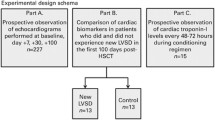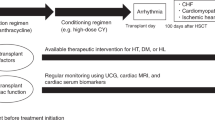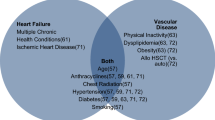Abstract
The long-term prognosis of patients after haematopoietic stem cell transplantation (HSCT) has greatly improved. Cardiac complications represent unresolved and potentially life-threatening conditions in these patients. We prospectively examined 37 consecutive patients with a median age of 28 years who underwent allogeneic HSCT. Biomarkers of cardiac injury were measured serially before the conditioning regimen, the first day after HSCT and then 14, 30, 90 and 180 days after HSCT. Echocardiography was performed before and 1 month after HSCT. Eleven patients (30 %) had persistently increased NT-proBNP values, 14 patients (38 %) had only transient elevations and 12 (32 %) had no changes in NT-proBNP concentrations for a period exceeding 14 days after HSCT. Elevated NT-proBNP values at day 14 after HSCT remained an independent predictor of cardiotoxicity during the first 6 months after HSCT (P < 0.01). Patients with persistent elevations in NT-proBNP also had significant elevations in hs-cTnT concentrations (P < 0.01). Only patients with persistently increased NT-proBNP had a significant worsening in systolic and some diastolic echocardiographic parameters, and we observed in this group the highest values of both cardiomarkers during the 6-month period. Forty-five percent of these patients developed clinical manifestation of cardiotoxicity. Elevations in NT-proBNP concentrations at day 14 after HSCT can predict patients at risk of developing cardiac events during the first 6 months after HSCT. Simultaneous elevations of both cardiomarkers (NT-proBNP and hs-cTnT) persisting 14 days after HSCT had a sensitivity of 83 % and a specificity of 80.69 %.



Similar content being viewed by others
References
Passweg, J. R., Baldomero, H., Gratwohl, A., Bregni, M., Cesaro, S., Dreger, P., et al. (2012). The EBMT activity survey: 1990–2010. Bone Marrow Transplantation, 47, 906–923.
Martin, P. J., Counts, G. W, Jr, Appelbaum, F. R., Lee, S. J., Sanders, J. E., Deeg, H. J., et al. (2010). Life expectancy in patients surviving more than 5 years after hematopoietic cell transplantation. Journal of Clinical Oncology, 28, 1011–1016.
Bresters, D., van Gils, I. C., Kollen, W. J., Ball, L. M., Oostdijk, W., van der Bom, J. G., et al. (2010). High burden of late effects after haematopoietic stem cell transplantation in childhood: A single-centre study. Bone Marrow Transplantation, 45, 79–85.
Sun, C. L., Francisco, L., Kawashima, T., Leisenring, W., Robison, L. L., Baker, K. S., et al. (2010). Prevalence and predictors of chronic health conditions after hematopoietic cell transplantation: A report from the bone marrow transplant survivor study. Blood, 116, 3129–3139.
Carver, J. R., & Desai, C. J. (2010). Cardiovascular toxicity of antitumor drugs: Dimensions of the problem in adult settings. In G. Minotti (Ed.), Cardiotoxicity of non-cardiovascular drugs (pp. 127–199). New York: Wiley.
Chow, E. J., Wong, K., Lee, S. J., Cushing-Haugen, K. L., Flowers, M. E., Friedman, D. L., et al. (2014). Late cardiovascular complications after hematopoietic cell transplantation. Biology of Blood Marrow and Transplantation, 20(6), 794–800. doi:10.1016/j.bbmt.2014.02.012.
Monsuez, J. J. (2012). Detection and prevention of cardiac complications of cancer chemotherapy. Archives of Cardiovascular Diseases, 105, 593–604.
Herman, E. H., Zhang, J., Lipshultz, S. E., Rifai, N., Chadwick, D., Takeda, K., et al. (1999). Correlation between serum levels of cardiac troponin-T and the severity of the chronic cardiomyopathy induced by doxorubicin. Journal of Clinical Oncology, 17, 2237–2243.
Januzzi, J. L., Van Kimmenade, R., Lainchbury, J., Bayes-Genis, A., Ordonez-Llanos, J., Santalo-Bel, M., et al. (2006). NT-proBNP testing for diagnosis and short-term prognosis in acute destabilized heart failure: An international pooled analysis of 1256 patients: The International Collaborative of NT-proBNP Study. European Heart Journal, 27(3), 330–337.
Albini, A., Pennesi, G., Donatelli, F., Cammarota, R., De Flora, S., & Noonan, D. M. (2010). Cardiotoxicity of anticancer drugs: The need for cardio-oncology and cardio-oncological prevention. Journal of the Egyptian National Cancer Institute, 102, 14–25.
Snowden, J. A., Hill, G. R., Hunt, P., Carnoutsos, S., Spearing, R. L., Espiner, E., et al. (2000). Assessment of cardiotoxicity during haemopoietic stem cell transplantation with plasma brain natriuretic peptide. Bone Marrow Transplantation, 26, 309–313.
Niwa, N., Watanabe, E., Hamaguchi, M., Kodera, Y., Miyazaki, H., Kodama, I., et al. (2001). Early and late elevation of plasma atrial and brain natriuretic peptides in patients after bone marrow transplantation. Annals of Hematology, 80, 460–465.
Masuko, M., Ito, M., Kurasaki, T., Yano, T., Takizawa, J., Toba, K., et al. (2007). Plasma brain natriuretic peptide during myeloablative stem cell transplantation. Internal Medicine, 46, 551–555.
Horacek, J. M., Pudil, R., Tichy, M., Jebavy, L., Zak, P., Slovacek, L., et al. (2007). Biochemical markers and assessment of cardiotoxicity during preparative regimen and hematopoietic cell transplantation in acute leukemia. Experimental Oncology, 29, 343–347.
Sandri, M. T., Salvatici, M., Cardinale, D., Zorzino, L., Passerini, R., Lentati, P., et al. (2005). N-terminal pro-B-type natriuretic peptide after high-dose chemotherapy: A marker predictive of cardiac dysfunction? Clinical Chemistry, 51, 1405–1410.
Roziakova, L., Bojtarova, E., Mistrik, M., Dubrava, J., Gergel, J., Lenkova, N., et al. (2012). Serial measurements of cardiac biomarkers in patients after allogeneic hematopoietic stem cell transplantation. Journal of Experimental and Clinical Cancer Research, 31, 13. doi:10.1186/1756-9966-31-13.
Mavinkurve-Groothui, A. M., Kapusta, L., Nir, A., & Groot-Loonen, J. (2008). The role of biomarkers in the early detection of anthracycline-induced cardiotoxicity in children: A review of the literature. Pediatric Hematology and Oncology, 25, 655–664.
Poutanen, T., Tikanoja, T., Riikonen, P., Silvast, A., & Perkkiö, M. (2003). Long-term prospective follow-up study of cardiac function after cardiotoxic therapy for malignancy in children. Journal of Clinical Oncology, 21, 2349–2356.
Daugaard, G., Lassen, U., Bie, P., Pedersen, E. B., Jensen, K. T., Abildgaard, U., et al. (2005). Natriuretic peptides in the monitoring of anthracycline induced reduction in left ventricular ejection fraction. European Journal of Heart Failure, 7, 87–93.
Suter, T. M., & Ewer, M. S. (2013). Cancer drugs and the heart: Importance and management. European Heart Journal, 34, 1102–1111.
van Dalen, E. C., Caron, H. N., Dickinson, H. O., & Kremer, L. C. (2011). Cardioprotective interventions for cancer patients receiving anthracyclines. Cochrane Database of Systematic Reviews. doi:10.1002/14651858.CD003917.pub4.
Curigliano, G., Cardinale, D., Suter, T., Plataniotis, G., de Azambuja, E., Sandri, M.T., Criscitiello, C., Goldhirsch, A., Cipolla, C., Roila, F.; ESMO Guidelines Working Group. (2012). Cardiovascular toxicity induced by chemotherapy, targeted agents and radiotherapy: ESMO clinical practice guidelines. Annals of Oncology, 23, 155–166.
Sherief, L. M., Kamal, A. G., Khalek, E. A., Kamal, N. M., Soliman, A. A., & Esh, A. M. (2012). Biomarkers and early detection of late onset anthracycline-induced cardiotoxicity in children. Hematology, 17, 151–156.
Romano, S., Fratini, S., Ricevuto, E., Procaccini, V., Stifano, G., Mancini, M., et al. (2011). Serial measurements of NT-proBNP are predictive of not-high-dose anthracycline cardiotoxicity in breast cancer patients. British Journal of Cancer, 105, 1663–1668.
Sawaya, H., Sebag, I. A., Plana, J. C., Januzzi, J. L., Ky, B., Cohen, V., et al. (2011). Early detection and prediction of cardiotoxicity in chemotherapy-treated patients. American Journal of Cardiology, 107, 1375–1380.
Sawaya, H., Sebag, I. A., Plana, J. C., Januzzi, J. L., Ky, B., Tan, T. C., et al. (2012). Assessment of echocardiography and biomarkers for the extended prediction of cardiotoxicity in patients treated with anthracyclines, taxanes, and trastuzumab. Circulation Cardiovascular Imaging, 5, 596–603.
Garrone, O., Crosetto, N., Nigro, C. L., Catzeddu, T., Vivenza, D., Monteverde, M., et al. (2012). Prediction of anthracycline cardiotoxicity after chemotherapy by biomarkers kinetic analysis. Cardiovascular Toxicology, 12(2), 135–142.
Cardinale, D., Lamantia, G., & Cipolla, C. M. (2006). Troponin I and cardiovascular risk stratification in patients with testicular cancer. Journal of Clinical Oncology, 24, 3508.
Cardinale, D., Sandri, M. T., Colombo, A., Boeri, M., Lamantia, G., Civelli, M., et al. (2004). Prognostic value of Troponin I in cardiac risk stratification of cancer patients undergoing high-dose chemotherapy. Circulation, 109, 2749–2754.
Cardinale, D., Sandri, M. T., Martinoni, A., Tricca, A., Civelli, M., Lamantia, G., et al. (2000). Left ventricular dysfunction predicted by early troponin l release after high-dose chemotherapy. Journal of the American College of Cardiology, 36, 517–521.
Ky, B., Putt, M., Sawaya, H., French, B., Januzzi, J. L, Jr, Sebag, I. A., et al. (2014). Early increases in multiple biomarkers predict subsequent cardiotoxicity in patients with breast cancer treated with doxorubicin, taxanes, and trastuzumab. Journal of the American College of Cardiology, 63(8), 809–816.
Cardinale, D., Colombo, A., Torrisi, R., Sandri, M. T., Civelli, M., Salvatici, M., et al. (2010). Trastuzumab-induced cardiotoxicity: Clinical and prognostic implications of troponin I evaluation. Journal of Clinical Oncology, 28(25), 3910–3916.
Majhail, N. S., Rizzo, J. D., Lee, S. J., Aljurf, M., Atsuta, Y., Bonfim, C., et al. (2012). Recommended screening and preventive practices for long-term survivors after hematopoietic cell transplantation. Revista Brasileira De Hematologia E Hemoterapia, 34, 109–133.
Mornoş, C., & Petrescu, L. (2013). Early detection of anthracycline-mediated cardiotoxicity: The value of considering both global longitudinal left ventricular strain and twist. Canadian Journal of Physiology and Pharmacology, 91, 601–607.
Chung, W. B., Yi, J. E., Jin, J. Y., Choi, Y. S., Park, C. S., Park, W. C., et al. (2013). Early cardiac function monitoring for detection of subclinical doxorubicin cardiotoxicity in young adult patients with breast cancer. Journal of Breast Cancer, 16, 178–183.
Acknowledgments
The authors thank Marek Polomsky, MD, from the University of Rochester, New York, USA, for revision of the manuscript. This work was supported by a grant from the Scientific Grant Agency of the Ministry of Education, Slovak Republic VEGA 1/0906/14 and the grant of the European Regional Development Fund—Project FNUSA-ICRC (No. CZ.1.05/1.1.00/02.0123).
Author information
Authors and Affiliations
Corresponding author
Rights and permissions
About this article
Cite this article
Roziakova, L., Mistrik, M., Batorova, A. et al. Can We Predict Clinical Cardiotoxicity with Cardiac Biomarkers in Patients After Haematopoietic Stem Cell Transplantation?. Cardiovasc Toxicol 15, 210–216 (2015). https://doi.org/10.1007/s12012-014-9286-7
Published:
Issue Date:
DOI: https://doi.org/10.1007/s12012-014-9286-7




